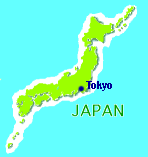|
After that, we met Takako, a good
friend of Kazuko. Takako stayed with us the rest of the day. Kazuko and Takako used to work
together. Takako speaks excellent English and she's really funny. She was
constantly making jokes or teasing us. Also, her Japanese is very distinctive.
With Takako in hand, we all went to the Edo Tokyo Museum.
We saw many relics from the Edo period in
Tokyo. It was an elaborate museum with some innovative exhibits. For example, they had a
huge model of a portion of Tokyo. The model was below the floor, which was made of glass.
This way, you could walk above the city. There were moving parts and a person narrating
the whole thing. The Edo Tokyo Museum also lets you touch many exhibits.
Here are a few photos I took inside the museum. The first one shows Takako posing
with some statues of geishas. The second one is Kazuko and Takako in a carriage together.
Third, Kazuko and I are posing with the geishas again. Fourth, I am inside a
palanquin, a thing for carrying important people. The last one is Kazuko inside the same
palanquin.
After the museum, we did some shopping. They helped me buy a digital camera at
Sakuraya. There was a complicated system with a point card. Without their help,
I never could have figured it out. My Japanese is not good enough for negotiating
complicated sales arrangements.
For my last night in Japan, Kazuko treated me to a night in a fine hotel called
"Tokyu". It was
a treat to go in and fall asleep quietly and wake up on my own. It was the best night
sleep of the trip, for sure. Before dinner, we stopped by the hotel
and dropped off my luggage.
For dinner, we went out to a fantastic sushi restaurant. We met up
with Mr. Takatsuji and Yu. Mr. Takatsuji is a good friend of the family, something like
an uncle. Yu is Fumi's brother and Kazuko's son. It was nice to sit and talk
and get to know Fumi's family a bit.
I challenged them
to find something I had never had before. Since this was the end of my trip, this was
a difficult task. The sushi was outstanding. This was definitely an extra special
restaurant. Here is the menu of what we had. Kazuko kindly wrote this out for me.
- maguro (tuna)
- akagai (red clam)
- awabi (abalone)
- hotate (scallops)
- anago (conger eel)
- iwashi (sardine)
- saba (mackerel)
- uni (sea urchin)
- ikura (salmon roe)
- mentaiko (cod)
- sake
- beer
As you see, we had quite a feast. I don't think I could pick favorites. Everything tasted
fresh and satisfying. It was great.
Unfortunately, I left my camera at the museum, so I didn't get a chance to take any pictures
at dinner.
|
 Tokyo
Tokyo





